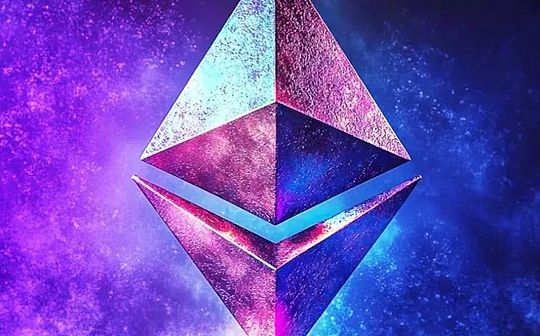
Introduction to Ethereum
Asset Type: Blockchain Infrastructure
Consensus mechanism: Proof of Stake
Start date: July 2015
Maximum supply: no upper limit
Key Points
• Ethereum is the pioneer in the innovation of smart contracts (automatic code execution on blockchain) on decentralized platforms.
• ETH is a native token of the Ethereum network and is used to pay transaction fees.
• Ethereum has an ongoing medium-term roadmap and implements upgrades every year.
Advantages:
• Ethereum has accumulated strong network effects with its leading edge as a smart contract platform.
• Ethereum prioritizes security and decentralization, providing users with greater reliability, censorship resistance and transparency than existing smart contract competitors.
• Ethereum can generate free cash flow through transaction fees ETH holders, reduce overall supply, and operate like an automated stock buyback system.
• Ethereum is fundamentally different from Bitcoin in terms of functionality and can be regarded as a potential portfolio diversification tool.
weakness:
• Ethereum’s modular expansion method has attracted more users at the expense of a certain value capture.
• Ethereum’s decentralization approach is between Bitcoin and Solana, making it more vulnerable to competitive threats in terms of its monetary commodities and overall performance.
• Ethereum upgrades are approximately once a year, and each network change is accompanied by potential risks, investors should consider it carefully.
What is Ethereum and its value proposition?
Ethereum was founded in 2013 by Vitalik Buterin and launched in 2015.In Ethereum, Buterin said: “The Ethereum protocol provides a platform with unique potential; it is not a closed, single-purpose protocol designed for specific data storage, or financial applications. Ethereum is open-ended in design and we believe it is ideally suited to be the foundation layer of many future financial and non-financial protocols.”
The Ethereum protocol is a digital space canvas for developers, and applications can be encoded into reality and secured by computer networks distributed around the world..
These applications made up of smart contracts are at the heart of Ethereum’s value proposition.The general capabilities of smart contracts and their differences with Internet applications will be further explored in the “Technology” section of this report.
The decentralized nature of the Ethereum protocol is the key to distinguish it from its competitors.Its open design enables the protocol to be used extensively and creatively.This combination of practicality and decentralization has made Ethereum’s native currency, ETH, the largest digital asset with market value, worth nearly US$300 billion.
ETH is essential for trading on the Ethereum network.Each transaction contains a transaction fee, i.e., the “gas fee”, which is paid for by ETH to complete the transaction.Whether developers create and publish new applications, or users interact with applications, ETH is required to pay these transaction fees.
Investment logic
The need for Ethereum network to use ETH is at the core of its investment logic.
In theory, if the demand for applications on the Ethereum network increases over time, the demand for ETH should also increase..
Just as Bitcoin represents a non-sovereign value storage and payment method, Ethereum represents a global, open source application network.
Therefore, this report believes thatNetworks like Ethereum have the potential to follow the typical adoption curves of other life-oriented technologies.
Decentralized finance and stablecoins represent a considerable part of the current activity of the Ethereum network.Although Ethereum has financial attributes in nature, applications built on Ethereum cover all computing possibilities and cast a pan-root for accessible market scope.
The supply of ETH comes from the issuance of proof of stake and is more stable than other currencies.Its mechanism specifically prevents hyperinflation and has a net inflation rate of up to 1.5% per year.In practice, based on the current design, the ETH supply will fluctuate moderately in the range of -1% to 1%.
Combining the inherent demand adopted by the network with stable supply allows investors to clearly understand what shape the investment logic will take when it is highly dependent on the adoption curve in the future.This allows investors to judge for themselves the scope of adoption results and identify whether this demand trend is worth investing.
However, with Ethereum’s continued development roadmap, investors need to continuously monitor and adjust their investment logic accordingly..
Historical and future initial token allocation
The Ethereum ecosystem that exists today is very different from the network launched in 2015.
Ethereum was initially launched as a proof-of-work blockchain, a system for miners to verify transactions and secure network security by solving computing challenges, and raised funds for the Ethereum Foundation through Genesis Sales.

Interestingly, the difference between Ethereum’s pre-creation supply and its current supply is mainly attributed to the allocation of proof of work.
This allows ETH to obtain a broad distribution similar to Bitcoin in its early years compared to other proof-of-stake networks.
This general distribution lays a solid foundation for the network’s transition to proof of stake, as a considerable portion of the supply is allocated to Ethereum proof of work miners.
Turn to proof of interest
Ethereum’s “TheMerge” merger upgrade marks a critical transition from proof of work to proof of stake.
This transformation began with the launch of the beacon chain in 2020 and was completed in 2022, integrating the beacon chain with the Ethereum main network.
This shift significantly reduced Ethereum’s energy consumption by about 99.95% and reduced ETH issuance by about 89%, thus stabilizing supply.
Since “TheMerge”, a significant reduction in issuance volume has consolidated the stability of ETH supply.
Under the proof of stake mechanism, the constraints of ETH issuance ensure that network security can continue to increase without becoming too expensive to maintain.
ETH supply
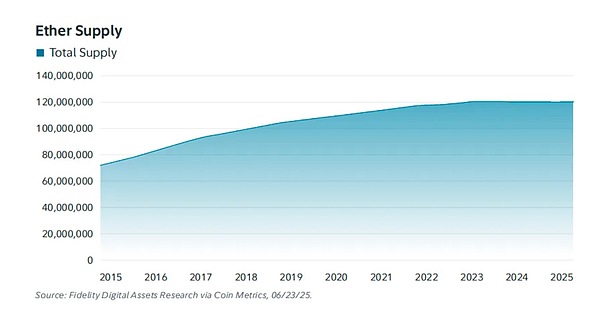
Modular approach to extension
In 2021, due to high demand, Ethereum faces significant expansion challenges, resulting in extremely high transaction costs.The modular approach of extension solves these problems by separating different functions into different layers.This approach allows for more efficient processing of transactions and managing data.The main focus of Ethereum remains to be a secure, decentralized data availability layer, leveraging modular approaches to facilitate transaction execution.
Roadmap
Given the impact each upgrade may have on the network, it is important to understand Ethereum’s roadmap and the changes that may occur.Ethereum is a growing network—and investors should pay attention to this and plan accordingly.
Strategic Measures
• Expand Layer1 to provide enough block space to accommodate all asset issuance, governance, DeFi and Layer2 settlement activities.
• Extend blobs (temporary data packets introduced to improve data availability and reduce costs) to provide the most attractive digital asset data availability scenarios.
• Improve user experience to provide a unified, seamless and secure experience throughout the Ethereum ecosystem.
These initiatives can be found on the “Strategic Measures” page of the Ethereum Foundation website.
Governance-Ethereum Foundation
The Ethereum Foundation is a non-profit organization dedicated to supporting the entire Ethereum ecosystem.The organization’s functions include assisting in funding protocol development, expanding the ecosystem, and advocating for Ethereum.Its executive committee consists of three members, including Butling.
Since its inception in 2015, the Ethereum Foundation has adhered to two core principles: far-reaching thinking and subtraction.
The Ethereum Foundation believes that its work will be measured based on long-term effects, with reference time spans ranging from years to hundreds of years, rather than quarterly and fiscal years.
Furthermore, it uses subtraction as a guiding principle.This means reducing one’s own power where possible and resisting what it believes is that organizations naturally tend to expand and accumulate power.
The overall goal of the Ethereum Foundation is to allow the network to thrive with the support of a pan-community rather than relying on the foundation and its board of directors.
The most specific role of the Ethereum Foundation in the entire ecosystem is funding support.
At the time of initial token issuance, the Ethereum Foundation received 3.5 million ETH and had an annual budget of approximately US$100 million to fund all aspects of the R&D field.
The allocation of funds in 2023 is as follows:
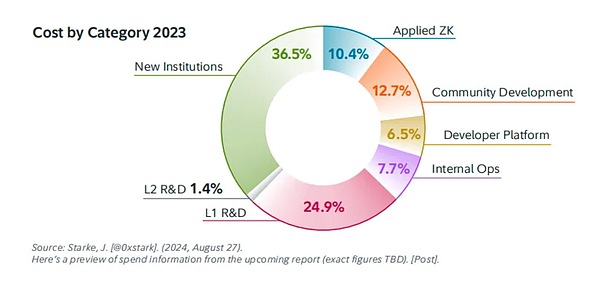
The amount of funds and allocations are constantly changing according to what the community believes should be prioritized.
While the Ethereum Foundation will not directly determine what the community should do, it has some influence on directing funds to its areas of interest.
Overall, the Ethereum Foundation plays a crucial role in the Ethereum ecosystem, supported primarily through research and funding.However, the organization does work to reduce this effect over time.
Ethereum improvement proposals and upgrades
Ethereum governance involves a structured process of proposing and implementing changes through the Ethereum Improvement Proposal (EIP).These proposals are discussed in the All Core Developers (ACD) meeting where developers coordinate upgrades.The process begins with drafting an EIP that is subsequently reviewed and discussed by the community.If the proposal receives overwhelming community support, it will undergo rigorous testing and security audits.
It should be noted that decisions on how to improve Ethereum’s governance are made off-chain.The decision-making process takes place in public forums, allowing changes to come from within the community rather than from top to bottom structurally driven.
Once an EIP is thoroughly reviewed, it will be included in a network upgrade to ensure the security and stability of the changes.These upgrades occur much less frequently than they did when the network was initially built.Developers generally expect that multiple proposals will be bundled into a single upgrade every year in the future.
Token Issuance
Ethereum’s “monetary policy”, namely token issuance, aims to achieve the minimum viable issuance volume and ensure the issuance of ETH to maintain network security.Although the issuance curve has been adjusted in the past, the main goal of minimizing issuance without affecting security is consistent.This approach balances security demand with a desire to limit inflation, often sparking debate about the optimal security threshold.
Technology-Smart Contract
Smart contracts are the key to making Ethereum unique.The easiest way to understand a smart contract is to think of it as program logic, which is similar to an application on a phone.
The core difference between Ethereum smart contracts and mobile applications is their location and operation.
Smart contracts that exist on Ethereum benefit from the auditability and availability of their blockchain.
This means that any user can view the logic of each app running and verify its legitimacy.
Furthermore, Ethereum has never experienced a complete downtime in history, providing extremely reliable runtime and accessibility to the applications it hosts.
This is different from many applications today, because its core logic is not usually exposed.It relies on greater trust in the application provider to ensure correct data processing and correct operating procedures.Finally, Internet-based applications rely on fewer servers to operate properly, which increases the possibility of downtime.
Therefore, smart contracts can provide the full functionality of other popular applications, while also benefiting from the greater transparency, censorship resistance and reliability provided by Ethereum.
Issuance and Destruction
Ethereum was initially launched using a proof-of-work consensus mechanism.However, its roadmap is always planned to eventually transition to proof of stake.
The shift to proof of stake has had a significant impact on the economics of the network and the investment characteristics of Ether.
The reduction in issuance through the merger, combined with the destruction mechanism implemented in 2021, will transform the Ethereum network into a productive asset that can return net cash flow to investors in the form of token destruction.
What investors need to understand is that Ethereum’s net cash flow is dynamic and will change according to the needs of the network and the continuous development of the protocol.
ETH supply since the merger
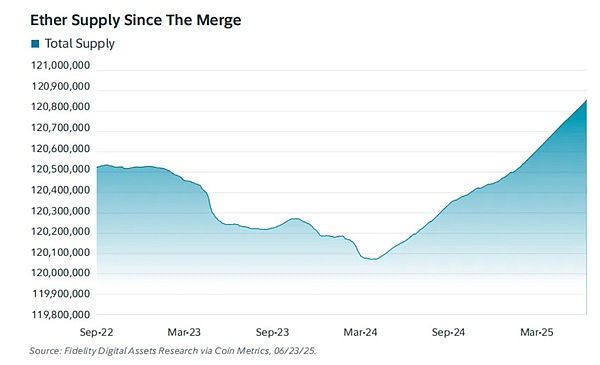
How does proof of stake work?
The transition from Ethereum to proof of stake, also known as mergers, brings a new way to prove that validators are adding value to the network.
To participate, the validator must deposit at least 32 ETHs into the smart contract and enter the activation queue.Once activated, a lottery-like system will be performed, and a validator is randomly selected to enter the slot to obtain the next block.
Every 12 seconds a new slot is available, with 32 slots per era (an era is the unit of time used in blockchain systems to group blocks or slots for processing and consensus).
Each block also includes a randomly selected validator committee to determine the blocks in the proposed blocks.This committee is necessary to manage network load and ensure participation of each active validator in each epoch.
The issuance of new ETH occurs at the consensus layer.
The amount of ETH obtained by each validator fluctuates depending on the total number of participating validators.
Ethereum’s destruction mechanism
Another major update to Ethereum in recent years is its destruction mechanism, which was launched as part of the London upgrade (the network upgrade in 2021 adjusted Ethereum’s fee structure and introduced a mechanism to destroy part of transaction fees, reducing supply over time).
Unlike Bitcoin, Ethereum’s supply is unlimited, and the destruction mechanism is implemented to incentivize network activity rather than staking, and now directly drives value to ETH holders through destruction or “token repurchase”.
To execute transactions on the Ethereum blockchain, the underlying fee is required.The underlying fee amount fluctuates between each block according to the transaction activity level.
In Ethereum’s proof-of-work system, this basic fee is rewarded to miners.However, through London upgrades and subsequent mergers, this basic fee shifted from rewards to miners to reducing the total supply through destruction.
Since the implementation of the destruction mechanism in August 2021, a total of 460,000 ETHs have been destroyed.As of June 23, 2025, this is equivalent to the ETH holder directly receiving $13 billion in value that should have been attributable to miners or validators.
Layer2 Rollups
There is a Layer2 on Ethereum where additional transactions occur.This Layer2 consists of many additional blockchains optimized for performance.On these blockchains, transactions are conducted at a larger quantity and at a lower fee.These transactions are integrated into a batch of transactions and shared on the first tier.
Through this process, transactions do not charge individual fees as they do at the base layer.Instead, they are processed in batches, paying a small percentage of the combined fees per transaction, thereby increasing efficiency and reducing user costs.
Storing Layer2 transaction data on Ethereum not only improves efficiency through batch processing, but also provides additional security for Layer2 users.Batch publishing transactions to Ethereum allows any interested party to verify that transactions shared from other blockchains are valid.
Therefore, the Layer2 blockchain can be optimized for performance and simply offload part of the security to Ethereum.
As of June 2025, the Prague-Electra upgrade was the latest network update, which occurred in May 2025.In this upgrade, developers doubled their existing blob capacity, further improving transaction efficiency.As a result, the Layer2 rollup transaction fee has been reduced and the burning ETH has also been reduced.The upgrade to scalability highlights the shield between ETH investors and users: higher fees are beneficial to investors due to the combustion mechanism.
The lower fees are beneficial to users because the transaction costs are lower.
ETH supply has increased since the Prague-Electra upgrade, indicating that the efficiency improvement has not been offset by trading activities.However, the net result is a lower inflation rate and a reduced expense, which can be considered an ideal balance point.
It is only in the early stages, and further upgrades may continue to change the network dynamics of Ethereum.Regardless, it may be worthwhile to monitor the inflation and deflation trends of ETH supply.
Basic Analysis
trade
Over the past four years, Ethereum has an average of 1.14 million transactions per day on its base layer.
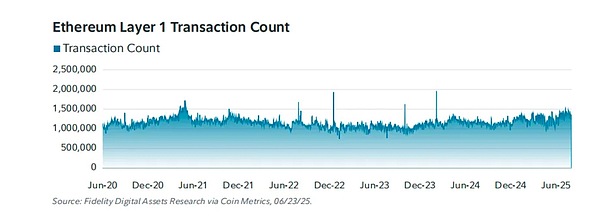
The most common use cases for trading on the Ethereum network include:
1. ETH transfer; 2. Stablecoins; 3. ERC-20 tokens; 4. Decentralized Finance (DeFi).
In 2025, these use cases account for 69% of all online transactions, which is an average of about 873,000 transactions per day.
Here is a complete breakdown of transaction types.
Ethereum transaction type decomposition
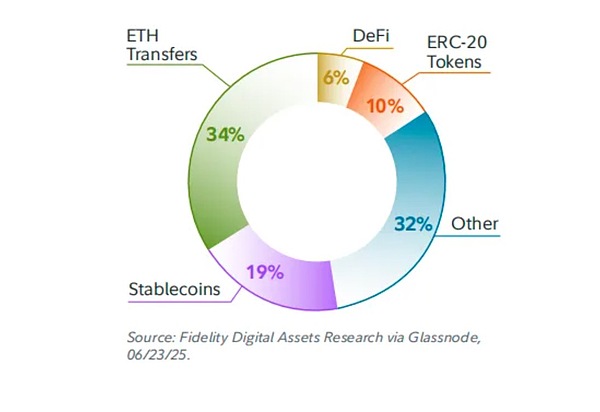
Ethereum ecosystem supports ETH
Similar to other non-native tokens.This is a significant difference compared to Bitcoin, as the latter supports only its native tokens.There are two types of non-native tokens most commonly found in ERC-20 tokens, where stablecoins are subcategory.
As shown in the above chart, supporting non-native tokens such as ERC-20 tokens and stablecoins is necessary because they account for 29% of daily transactions.
Smart contract function
Smart contract calls are a proxy indicator that measures the overall function of the network.Therefore, more calls mean more complex transactions occur and/or provide more utility to the user.
Since the launch of Ethereum, the number of smart contract calls initiated daily has been steadily increasing.
As of June 23, 2025, the network maintained a daily average of more than 7 million smart contract calls per day throughout 2025.
Since smart contracts are programming logic, this indicator can be used as a proxy for measuring the overall functionality of the network and user utility.
The continued increase in smart contract calls on Ethereum may indicate that users can facilitate more complex transactions than ever before, thus benefiting from the greater utility provided by network-built applications.Note that this data includes executed and failed smart contract calls, but still shows a significant increase in network utility.
Number of smart contract calls per day
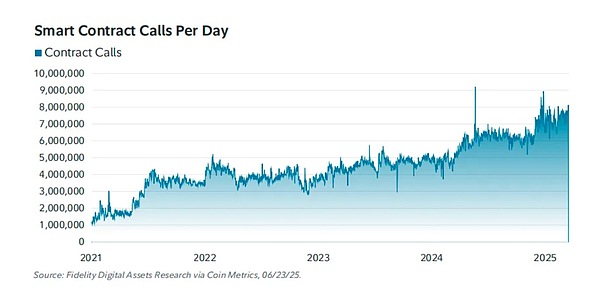
Layer2 Analysis
Ethereum relies on the Layer2 network to process most transactions to reduce costs, while the Layer2 network relies on Ethereum for its security and censorship resistance.
The two most popular types of Layer2 blockchains areZK-RollupsandOptimistic.
Although these two different types of blockchains perform the task of processing transactions, they obtain security from Ethereum in different ways.The specific differences in security assurance are more important to users using these blockchains.However, investors should realize that they all scale Ethereum and that their security mechanisms are different.
To measure the activity of these Rollups, this report will focus specifically on the number of transactions and number of active addresses per day.
Layer2 transactions and active addresses
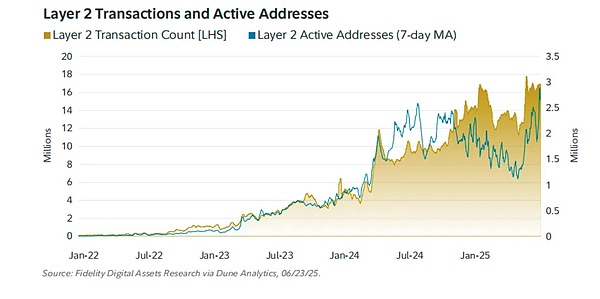
Between Optimistic and ZK-Rollups, about three million active users made 16 million transactions per day as of June 24, 2025.
The activity and user growth of these platforms have been significant over the past year, indicating that the Ethereum network can achieve continuous growth through modular scaling methods.
Judging from Metcalf’s law, the value of the Ethereum network has increased significantly in recent years due to this modular theory.
However, this approach does sacrifice value accumulation.
Compared with transactions on Layer1, transactions occurring on the Layer2 platform bring significantly less value to Ethereum in terms of cash flow.From the perspective of value accumulation and financial aspects, this trade-off is very obvious.
Before the introduction of blobs (a block space dedicated to Layer2 data), the Layer2 platform accounted for about 20% of all Ethereum revenue.After upgrading to reduce the fees incurred by Layer2, they now account for only about 1% of all costs.
Expansion through blobs specifically sacrifices the revenue and value increase of the Layer2 platform to reduce user fees and enhance network capabilities.
The leverage described in this describes lies between Metcalfe’s law and value growth.
Ethereum revenue is still likely to increase due to the massive increase in Layer2 activity, but this remains to be seen.
Therefore, the prospect of Ethereum’s long-term value increase depends on a significant increase in Layer2 user demand to compensate for the sacrificed revenue.
Competitor Analysis: Market Share/Dominance
There is always a possibility that new market leaders may replace Ethereum as a smart contract platform—a point Solana has proven to be Ethereum’s biggest competitor to date.
On April 20, 2025, Solana reached an all-time high when denominated in ETH: a SO can be exchanged for 0.087 ETH.
Market share trends
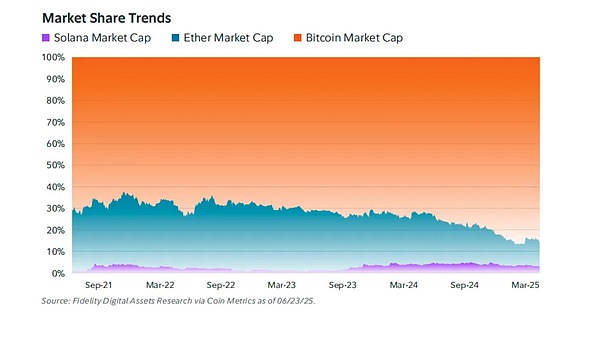
Solana is the most prominent example of Ethereum’s competitive risks.
The former offers low-cost layer 1 blockchains—sacrificing decentralization for convenience and efficiency—and currently seems to have proven its advantages.
By contrast, on Ethereum, investors need to transfer tokens to the Layer tier ecosystem to get the same environment as the high-performance, low-cost rate environment that Solana enjoys in the first layer.
This highlights a potential pain point for Ethereum, as developers face the classic blockchain triad.
The more scalable a chain is, the more transactions it can handle, and therefore the greater the value it directly obtains.
However, as blockchain performance requirements improve, the degree of centralization increases, and security guarantees also decrease.
Ethereum chose to maintain higher decentralization, while Solana is committed to maximizing performance.
By offloading transaction execution to the tier 1 platform, Ethereum has sacrificed some value growth to maintain decentralization.
Instead, Solana’s raw performance allows it to process millions of transactions per day that create value directly for Solana holders.
Whether investors, developers and users will prefer Ethereum to prioritize decentralization remains to be seen.
However, in the short term, Solana has made significant progress in market share by adopting a more concentrated approach.
Bitcoin, on the other hand, has achieved success by focusing on extreme decentralization and simplicity rather than performance.
This shows that there is not only one way forward, as both Bitcoin and Solana have grown with completely different strategies (and use cases).
However, this space may be large enough to allow various blockchains to coexist with different levels of decentralization.
For investors, the question is which parts of the three difficult problems of blockchain are most useful.
Price performance
Price returns by time period
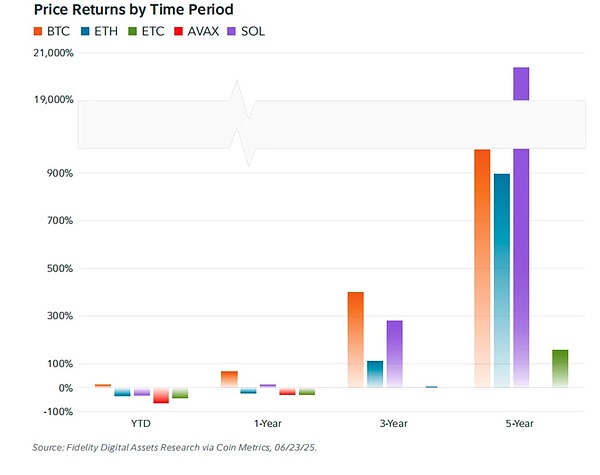
BTC and SOL outperform ETH for each listed time period, indicating that competition for Ethereum has never been more intense.
Although ETH still performs well within the time frame of the period, investors should seriously consider the risks of its successful future competition with Ethereum.
Recent price performance may be due to the over-expansion of ETH in 2021 and needs to be repriced relative to competitors.However, this may also show a shift in overall market preference.
It is worth noting that Ethereum Classic (ETC) is a hard fork in Ethereum in its early days and has always performed inferior to ETH throughout its life cycle (hard fork refers to a permanent split when blockchain rules change).
This can be seen as a sign that developer activity and community support plays an important role in the valuation of smart contract platforms.
Despite their similar history, Ethereum has been able to meet market demand with greater capabilities through its continued development of blockchain.
Token Basics (2025 Average)

From the fundamentals of 2025, despite the obvious performance advantages of Solana, most of the value locked in smart contracts or stablecoins is still in Ethereum, demonstrating the power of network effects.
In addition, the ratio of Ethereum users to transactions compared to Solana shows that the average user transaction volume on Solana is significantly higher than Ethereum.
Finance and Valuation (2025 Annualization)

Ethereum has recently lagged behind Solana in terms of total expenses and token holder revenues due to strong expansion efforts.
While this continues to drive strong user demand for the Ethereum ecosystem, demand for using Ethereum has not yet matched the scaling improvements.
It should be noted that each network has its own unique issuance and expense mechanism, which may change the flow of value captured by each network.
Take Bitcoin as an example, all fees belong to the miner, which dilutes Bitcoin holders at issuance speed.
When looking at other networks that burn some of the costs, you can use “fee reduction issuance” to understand how much issuance dilution for the expenses.
Importantly, Proof of Work Security is a consistently competitive market, which usually requires miners to sell most of the issuance they capture.
Instead, proof-of-stake cybersecurity does not usually require the same amount of ongoing costs.Therefore, inflation is unlikely to negatively affect prices to the same extent.
Scenario Analysis
City Scenario: Smart contract platforms have created new aspects of society by enhancing global coordination and trust.Thanks to continuous innovation, Ethereum remains the leading smart contract platform.Many users and businesses choose Ethereum for their decentralization, security, transparency and reliability, and these advantages are implemented without sacrificing the user experience.
Trading on the Layer2 platform is frequently to keep a single cost low while generating significant cumulative revenue for Ethereum holders.
Basic: Smart contract platforms improve specific parts of financial and non-financial markets, acting as a check and balance mechanism in a traditional system dominated by governments and large enterprises.Many users and businesses benefit from a decentralized smart contract network.
However, due to Ethereum’s inherent financial properties, its growth rate is slower than typical technology adoption curves.
While it is still growing and will eventually account for a certain percentage of its reachable market, its integration into all aspects of society is slower than technologies such as mobile phones or the Internet.
Ethereum remains a dominant smart contract platform, providing investors with reasonable value growth prospects.However, specialized competition limits Ethereum’s market share to applications that require the highest security and trust.
Bearish theory: Smart contract platforms experience cyclical trends, but fail to produce products that are expected.Centralized systems continue to innovate to provide users with more practical functions, while distributed systems are relatively lagging.Most digital interactions do not prioritize decentralization, censorship resistance or transparency.
The slow and inconsistent growth of the Ethereum network has resulted in the inability to attract a large number of users, hindering the accumulation of value for Ethereum holders.Additionally, Ethereum’s market share may decline as competitors may provide a better user experience for a few applications that benefit from smart contract platforms.
Risk and uncertainty
Like all other digital assets, Ether faces risks associated with its investment attributes.The most commonly mentioned is its significant volatility.Ether and other digital assets often experience substantial cyclical declines, which should make investors pay special attention to the investment time frame and appropriate allocation scale.
Compared to traditional financial markets, digital assets operate in areas with weaker regulatory environments, meaning that these investments may lack the protection and transparency that investors are used to.These risks can manifest as fraud or market manipulation, in which case investors often have limited or non-existent legal remedies.
For example, there is often no regulatory oversight of deposit insurance or exchanges, which can leave investors vulnerable.
Regulators such as the Securities and Exchange Commission (SEC) and the Commodity Futures Trading Commission (CFTC) are increasingly focusing on the digital asset market to address these issues.However,
The regulatory environment is still evolving, which may bring risks and opportunities.Investors should be aware of regulatory dynamics and consider the potential risks involved in trading and investing in all digital assets.
The rest of this section will focus on the inherent risks of Ethereum, which may or may not be applicable to other digital assets.
Competitive risk
Ethereum faces competition risks from multiple blockchains.This kind of risk may come from existing blockchains or newly created blockchains, as the emergence of Solana in 2020 is an example.With the increasing popularity of blockchain technology and intensified competition, outdated risks have also increased.
Technical risks
The Ethereum community usually tries to upgrade the protocol every year.
These upgrades bundle multiple EIPs together and implement them all at once.Each time an upgrade occurs, the code used by Ethereum runs is changed.With these changes comes the additional risks that investors should know.Since many investors may not be able to verify the accuracy of these changes at all, this risk will exist and gradually decrease over time, as the Lindy effect suggests.
Regulatory risks
The Ethereum core protocol has overcome a major hurdle in the regulatory journey with the approval of Ethereum Spot Exchange Trading Products (ETPs) in 2024.Although this approval indicates that assets such as ether meet certain regulatory standards, future regulatory enforcement may still be
It has a significant impact on the development of the ecosystem.It should be noted that the ecosystem of all applications on Ethereum still requires regulatory clarification, as well as banking institutions that provide valuable access to and from the environment.
Governance risks
The most direct impact of Ethereum governance on the network is to determine which parts of Ethereum will change.The governance process of Ethereum is driven by the community, posed two widely cited challenges.
First, changes in Ethereum often affect stakeholders in the community in many ways, and reaching consensus on certain decisions can be difficult — and sometimes impossible.
Such structures have and may lead to slower development relative to other networks that may have a more top-down structure and can therefore act faster.
The second risk associated with Ethereum governance is described as a “soft impact”.
This type of risk is difficult to quantify and is difficult to weigh appropriately for investors.This concept refers to the gradual change in the cultural values held by the community, thus benefiting some stakeholders from others.
Soft effects usually occur over time and are any risk in the human governance structure.
It should also be noted that there may be a related “key person risk”.Buterin, co-founder of Ethereum, is still actively working on the network, conducting important research, and is regarded as a leader by many.This potentially gives Buterin an overwhelming influence on the community in shaping direction and intention.
Investors must understand that it is to control the direction of the network manually and make frequent decisions to decide this direction.It is generally believed that community-led governance is most likely to bring the best results for the largest majority, but it is unrealistic to benefit and prioritize each stakeholder equally.







